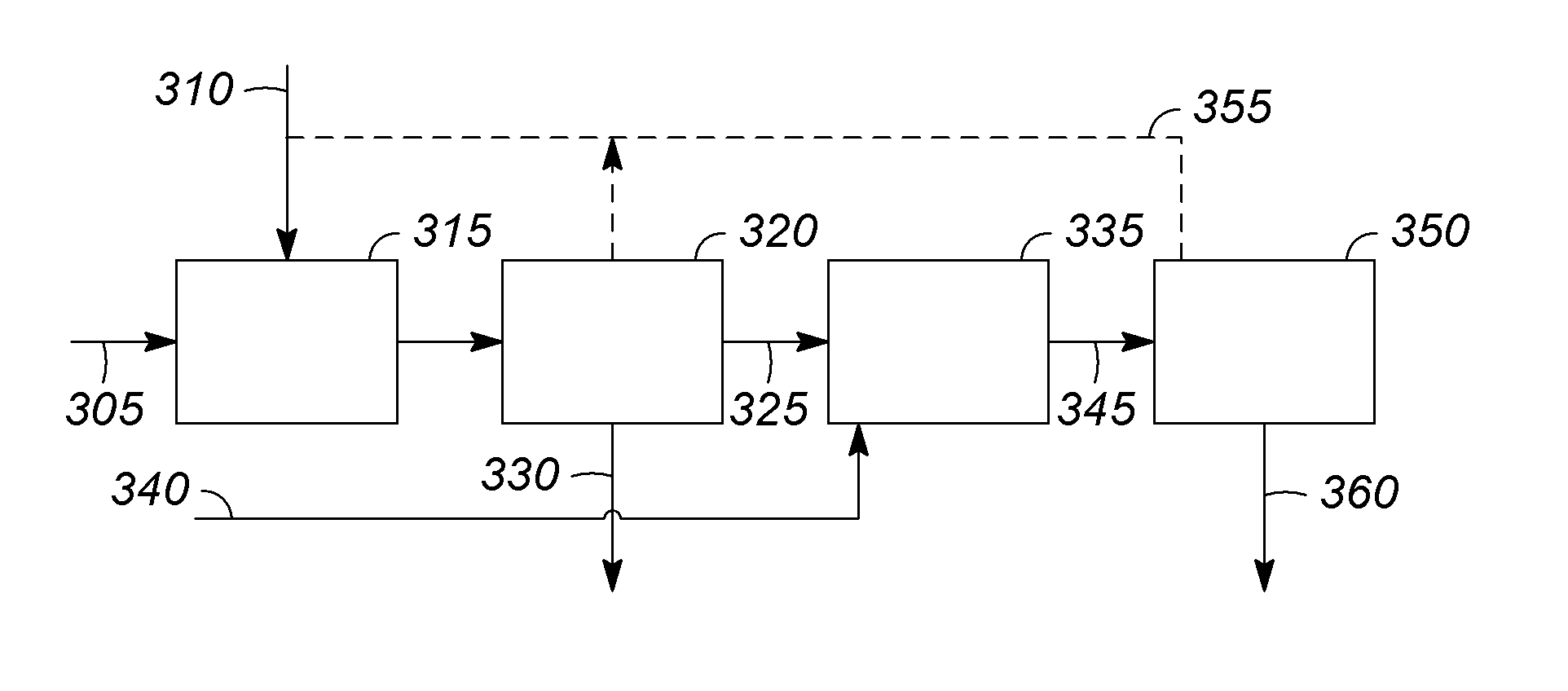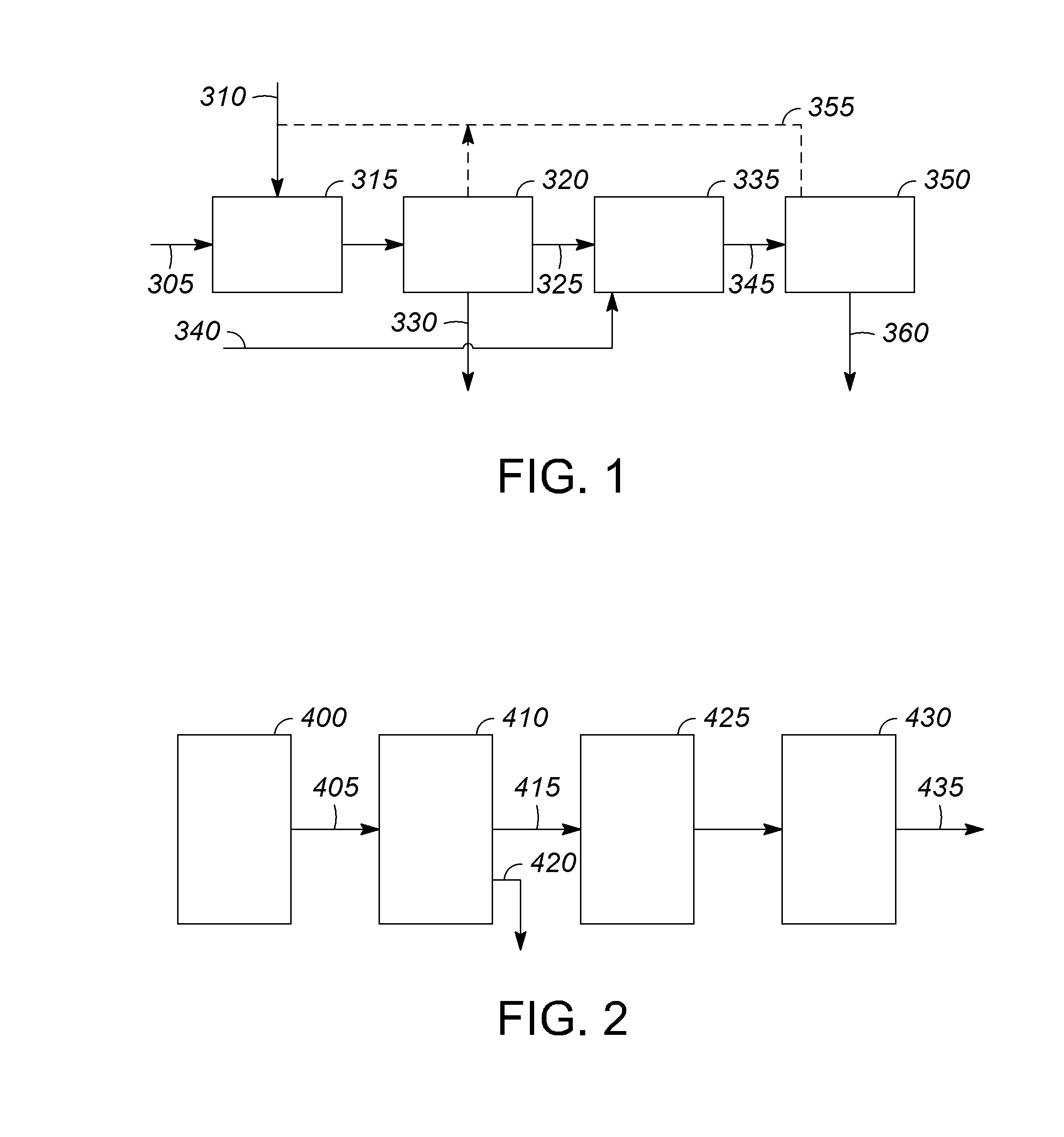Integrated hydrolysis/hydroprocessing process for converting feedstocks containing renewable glycerides to paraffins
a technology of hydrolysis and hydroprocessing process, which is applied in the direction of fatty acid chemical modification, sustainable manufacturing/processing, fatty substance recovery, etc., can solve the problems of high investment cost and operating cost, and the current process of producing transportation fuel from renewable feedstocks is criticized
- Summary
- Abstract
- Description
- Claims
- Application Information
AI Technical Summary
Benefits of technology
Problems solved by technology
Method used
Image
Examples
example 1
[0082]A simplified comparison of the two step hydrolysis followed by hydrodeoxygenation process with a stand alone hydrodeoxygenation process is shown in Table 1. In both cases, full conversion of feed oxygenate to water is assumed.
TABLE 1Hydrolysis / MassMassHydrodeoxygenationUnitsHydrodeoxygenationUnitsC16 Triglyceride100.0C16 Triglyceride100.0H2O6.7Hydrolysis ProductsC16 FFA95.3Glycerol11.4106.7Hydrodeoxygenation InputsC16 FFA95.3H22.2H23.097.5Hydrodeoxygenation ProductsPropane0.0Propane5.5Diesel Range Paraffins84.1Diesel Range Paraffins84.1Water13.4Water13.4
example 2
[0083]As shown in Table 2, a feedstock of brown grease with FFA to lipid weight ratio >0.3, a sulfur content over 500 wt-ppm and a metals (Na, Mg, Ca, Zn) content >1000 wt-ppm which was acid-washed was reported to reduce the metals concentration below 30 wt-ppm.
TABLE 2Brown Grease Feedstock and Acid-Washed ProductSNaMgCaZnBrown grease as received6403761107658HCl (aq) treated and washed4284.31.513.17brown grease
[0084]The acid-washed brown grease could then be hydrolyzed in the presence of an acid catalyst at subcritical conditions (e.g., temperature of less than about 350° C. and a pressure of less than about 6895 kPa(g) (1000 psig)) to convert >80% of the total lipids present to FFA. Hydrolysis reaction time would be about 75 minutes.
[0085]Using the separation and purification processes described, a free fatty acid stream substantially free of glycerol, water, and metals (e.g., having less than 10 wt-ppm metals, total glycerol <0.5% by weight, and total water content <1% by weight) ...
example 3
[0088]A feedstock of marine algae (nanochloropsis) with a dry basis neutral lipid content of 20% and a polar lipid content of 10% could be pretreated with an aqueous acid stream to remove at least a portion of the metals and cellulosic materials.
[0089]A lipid-enriched fraction would be recovered and then hydrolyzed in the presence of an acid catalyst at subcritical conditions to convert 98% of the neutral lipids and greater than about 50% of the polar lipids present to FFA. Hydrolysis reaction time would be about 90 minutes.
[0090]Using the separation and purification processes described, a free fatty acid stream substantially free of glycerol, water, and metals (e.g., having less than 10 wt-ppm metals, total glycerol <0.5% by weight, and total water content <1% by weight) could be recovered from the catalytic hydrolysis reactor effluent. A glycerol-containing co-product would also be generated.
[0091]The free fatty acid stream substantially free of glycerol, water, and metals would t...
PUM
| Property | Measurement | Unit |
|---|---|---|
| temperature | aaaaa | aaaaa |
| pressure | aaaaa | aaaaa |
| partial pressure | aaaaa | aaaaa |
Abstract
Description
Claims
Application Information
 Login to View More
Login to View More - R&D
- Intellectual Property
- Life Sciences
- Materials
- Tech Scout
- Unparalleled Data Quality
- Higher Quality Content
- 60% Fewer Hallucinations
Browse by: Latest US Patents, China's latest patents, Technical Efficacy Thesaurus, Application Domain, Technology Topic, Popular Technical Reports.
© 2025 PatSnap. All rights reserved.Legal|Privacy policy|Modern Slavery Act Transparency Statement|Sitemap|About US| Contact US: help@patsnap.com



